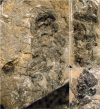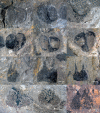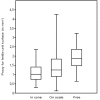A morphometric analysis of Tobleriabicuspis, a Voltziales seed cone from the early Permian Jambi palaeoflora, Sumatra (Indonesia)
- PMID: 31015778
- PMCID: PMC6443619
- DOI: 10.3897/phytokeys.119.29555
A morphometric analysis of Tobleriabicuspis, a Voltziales seed cone from the early Permian Jambi palaeoflora, Sumatra (Indonesia)
Abstract
Tobleriabicuspis, a coniferophyte seed cone, is described from the Jambi Palaeoflora, Sumatra of Asselian (early Permian) age. A morphometric analysis based on cones, paired fertile units, and fertile and sterile scales, demonstrates their close relationship. Small paired fertile units occur mainly in cones. Medium-sized paired fertile units occur mainly on scales. And large paired fertile units are mainly dispersed. The cones are considered female and the paired fertile units are considered to represent the seeds. The cones are composed of helicoidal, bilaterally symmetrical and deeply incised scales with paired seeds. A comparison can be made with the Voltziales female taxon Schizolepis from the Triassic and Jurassic. Tobleria is regarded as having a voltzian Voltziales affinity and dates from approximately 16 to 26 million years before any other such cones.
Keywords: Asselian; Cathaysia; early conifer cones; mesic-xeric.
Figures

















Similar articles
-
Understanding the cone scale in Cupressaceae: insights from seed-cone teratology in Glyptostrobus pensilis.PeerJ. 2018 Jun 1;6:e4948. doi: 10.7717/peerj.4948. eCollection 2018. PeerJ. 2018. PMID: 29868298 Free PMC article.
-
Middle Jurassic evidence for the origin of Cupressaceae: A paleobotanical context for the roles of regulatory genetics and development in the evolution of conifer seed cones.Am J Bot. 2015 Jun;102(6):942-61. doi: 10.3732/ajb.1500121. Epub 2015 Jun 16. Am J Bot. 2015. PMID: 26101419
-
Earliest evidence of granivory from China (Shanxi Formation) points to seeds as a food source and nursing habitat for insects in the earliest Permian humid tropical forests of Cathaysia.PLoS One. 2024 Oct 14;19(10):e0311737. doi: 10.1371/journal.pone.0311737. eCollection 2024. PLoS One. 2024. PMID: 39401203 Free PMC article.
-
Oviposition strategies of conifer seed chalcids in relation to host phenology.Naturwissenschaften. 2004 Oct;91(10):472-80. doi: 10.1007/s00114-004-0554-4. Naturwissenschaften. 2004. PMID: 15729760 Review.
-
Recurrent abnormalities in conifer cones and the evolutionary origins of flower-like structures.Trends Plant Sci. 2011 Mar;16(3):151-9. doi: 10.1016/j.tplants.2010.11.002. Epub 2010 Dec 7. Trends Plant Sci. 2011. PMID: 21144793 Review.
References
-
- Anderson JM, Anderson HM, Cleal CJ. (2007) Brief history of the gymnosperms: Classification, biodiversity, phytogeography and ecology. Strelitzia 20: 1–280.
-
- Archangelsky S, Cuneo R. (1987) Ferugliocladaceae, a new conifer family from the Permian of Gondwana. Review of Palaeobotany and Palynology 51(1–3): 3–30. 10.1016/0034-6667(87)90016-9 - DOI
-
- Barthel M, Bettag E, Noll R. (1998) Dicranophyllumhallei Remy & Remy im oberen Rotliegendes. Veröffentlichungen Museum für Naturkunde Chemnitz 21: 5–20.
-
- Booi M, Van Waveren IM, Van Konijnenburg-Van Cittert JHA, De Boer PL. (2008) New material of Macralethopteris from the Early Permian Jambi flora (Middle Sumatra, Indonesia) and its palaeoecological implications. Review of Palaeobotany and Palynology 152(3–4): 101–112. 10.1016/j.revpalbo.2008.04.009 - DOI
-
- Booi M, Van Waveren IM, Van Konijnenburg-Van Cittert JHA. (2009a) Comia and Rhachiphyllum from the Early Permian of Sumatra, Indonesia. Review of Palaeobotany and Palynology 156(3–4): 418–435. 10.1016/j.revpalbo.2009.04.007 - DOI
Publication types
LinkOut - more resources
Full Text Sources
